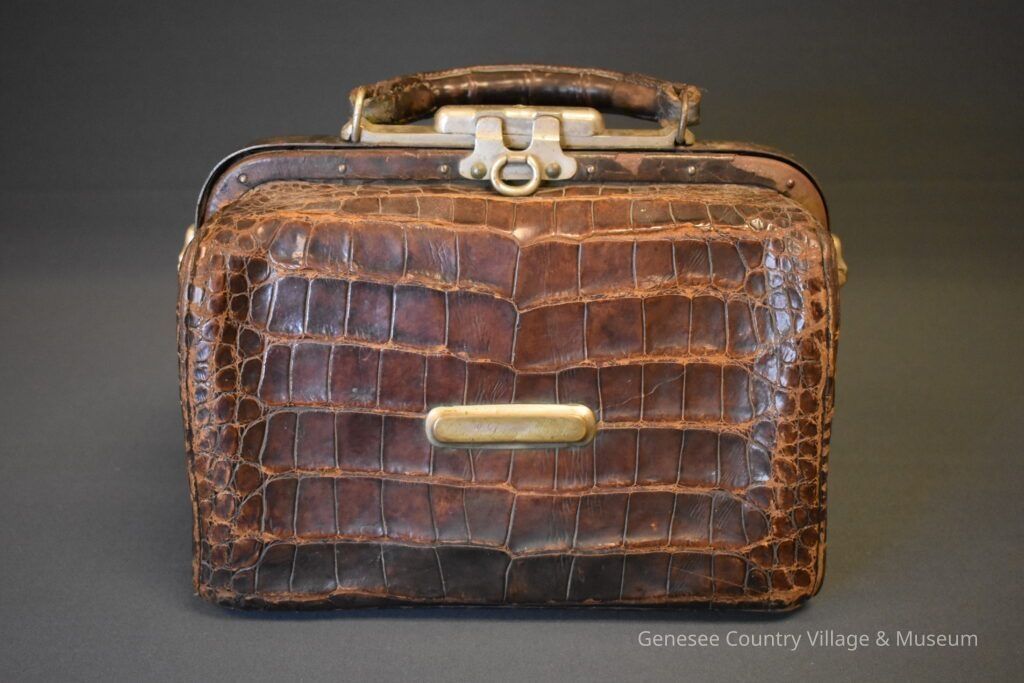Name/Title
Medical BagEntry/Object ID
1999.55.1Description
An alligator skin doctor’s bag. The bag has latches made of brass and a carry handle also in alligator. There is a brass plate on the front that is inscribed “Dr. J. Perry Horle.” The inside of the case has several compartments. One side has a removeable insert that holds eleven glass vials with corks and identified by paper labels. The back of the insert is covered in brown leather and has a pocket for papers and such. Behind this insert is space for an additional eight vials. On the other side of the case is space for eleven more vials. Underneath the vials is a compartment with a door made of brown leather and lined with purple velvet. Inside is a brass syringe and parts of a syringe. This bag was owned by Dr. John Perry Horle (1868-1927) of Fly Creek, NY.Context
Dr. Horle practiced a type of medicine called allopathy, which evolved into today’s modern medicine, or what is also known as mainstream medicine. During most of the 19th century homoeopathy was the dominate medical discipline in the United States. One of the major principles of homeopathy was “like cancels like”. For instance, if one had a stomachache, they would give a substance known to cause stomach aches. They also believed that by giving minute doses of medicinal agents it would allow the body to heal itself.
Allopathy, sometimes called heroic medicine, relied more on providing the patient with remedies that would cause an opposite effect than the symptoms they currently had. For instance, if a person had a stomachache, the opposite effect would be to have no stomachache. They did not follow the “like cancels like” philosophy of medication. Practitioners of homeopathy and allopathy were quite vocal in their complaints about each other. Homeopathic doctors claimed that the high doses practitioners of allopathic medicine gave their patients actually caused more diseases than they originally had. Homeopathic doctors criticized the frequent use of mercury and quinine by allopathic’ physician. Quinine we know is still used today to treat malaria, but we now understand that mercury is quite dangerous. However, homeopaths also used medication we now know to be dangerous such as arsenic and opium. Many doctors of all disciplines used substances such as cocaine, heroin, opium, arsenic, strychnine, mercury, and of course high volumes of alcohol, in medications for both adults and children. One advertisement from the late 19th century markets cocaine tooth drops for babies and children.
This particular bag was purchased from another living history village that had closed its doors. The bag was then sent to the Williamstown Art Conservation Center for cleaning and maintenance. Noticing that the vials still contained substances, they sent them to Williams College for analysis. They did indeed contain drugs that are either dangerous or controlled today. They found hazardous substances such as mercury as well as controlled substances like opioids, strychnine, digitalis, morphine, and atropine. One of the vials was labeled quinine as well. The contents of the vials had to be disposed of in the college’s hazardous waste facility as well as the DEA licensed Neuroscience department. Around the beginning of the 20th century allopathy had become the dominant medical practice although homeopathic practitioners and remedies are still popular with some today.Collection
Genesee Country Village and MuseumDimensions
Height
8 inWidth
5-1/2 inLength
11 inRelationships
Related Person or Organization
Person or Organization
Horle, Dr. John PerryRelated Places
Place
Town
Fly CreekState/Province
New YorkCountry
United States of AmericaContinent
North America
